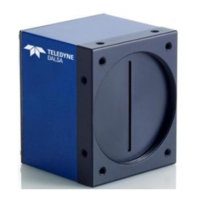Spyder3 S3-14 and S3-24 Monochrome Camera User's Manual 85
Teledyne DALSA 03-032-20117-01
Appendix B
Camera Link Reference, Timing, and
Configuration Table
Camera Link is a communication interface for vision applications. It provides a connectivity standard
between cameras and frame grabbers. A stand ard cable connection w ill reduce m anufacturers’ supp ort
time and greatly reduce the level of complexity and time needed for customers to successfully integrate
high speed cameras with frame grabbers. This is particularly relevant as signal and data transmissions
increase both in complexity and throughput. A standard cable/ connector assembly will also enable
customers to take advantage of volume pricing, thus reducing costs.
The camera link standard is intended to be extremely flexible in order to meet the needs of different
camera and frame grabber manufacturers.
The Teledyne DALSA Camera Link Implementation Road Map (available here) details how Teledyne
DALSA standardizes its use of the Camera Link interface.
LVDS Technical Description
Low Voltage Differential Signaling (LVDS) is a high speed, low power, general purpose interface
standard. The standard, known as ANSI/ TIA/ EIA-644, was approved in March 1996. LVDS uses
differential signaling, with a nominal signal swing of 350mV differential. The low signal swing decreases
rise and fall times to achieve a theoretical maximum transmission rate of 1.923 Gbps into a loss-less
medium. The low signal swing also means that the standard is not dependent on a particular supply
voltage. LVDS uses current-mode drivers, which limit power consumption. The differential signals are
immune to ±1 V common volt noise.
Camera Signal Requirements
This section provides definitions for the signals used in the Camera Link interface. The standard Camera
Link cable provides camera control signals, serial communication, and video data.
Video Data
The Channel Link technology is integral to the transmission of video data. Image data and image enable
signals are transmitted on the Channel Link bus. Four enable signals are defined as:
• FVAL—Frame Valid (FVAL) is defined HIGH for valid lines.
• LVAL—Line Valid (LVAL) is defined HIGH for valid pixels.
• DVAL—Data Valid (DVAL) is defined HIGH when data is valid.
• Spare— A spare has been defined for future use.
All four enable signals must be provided by the camera on each Channel Link chip. All unused data bits
must be tied to a known value by the camera. For more information on image data bit allocations, refer to
the official Camera Link specification located in the Knowledge Center on Teled yne DALSA’s website.

